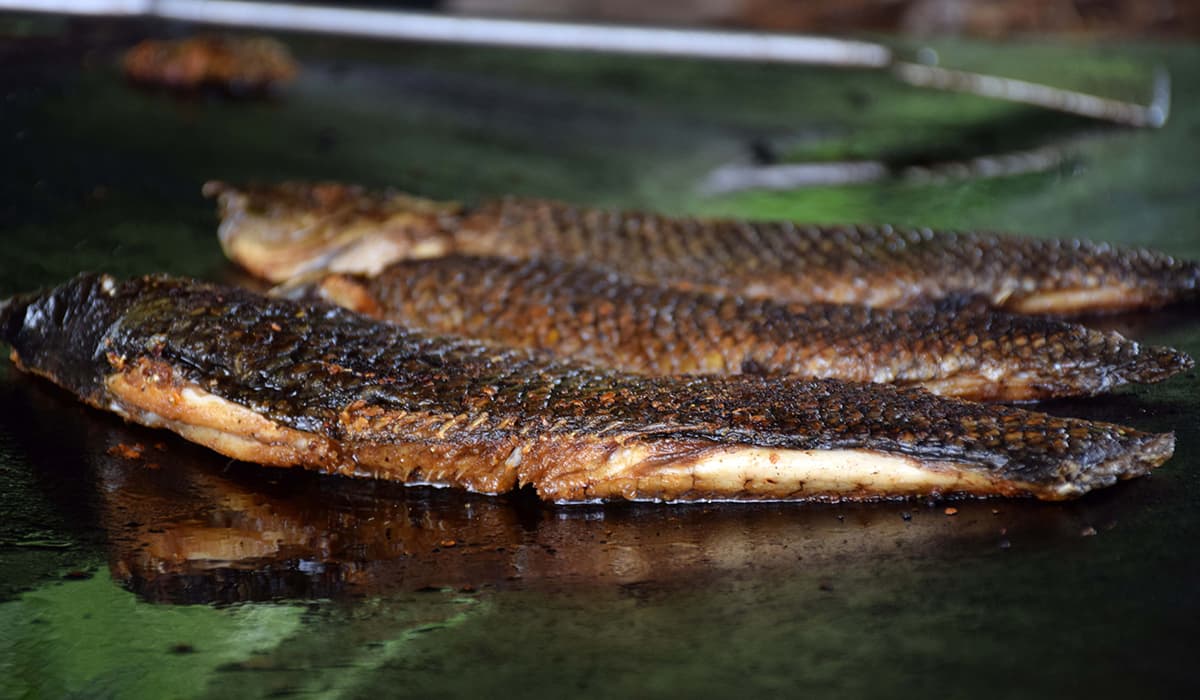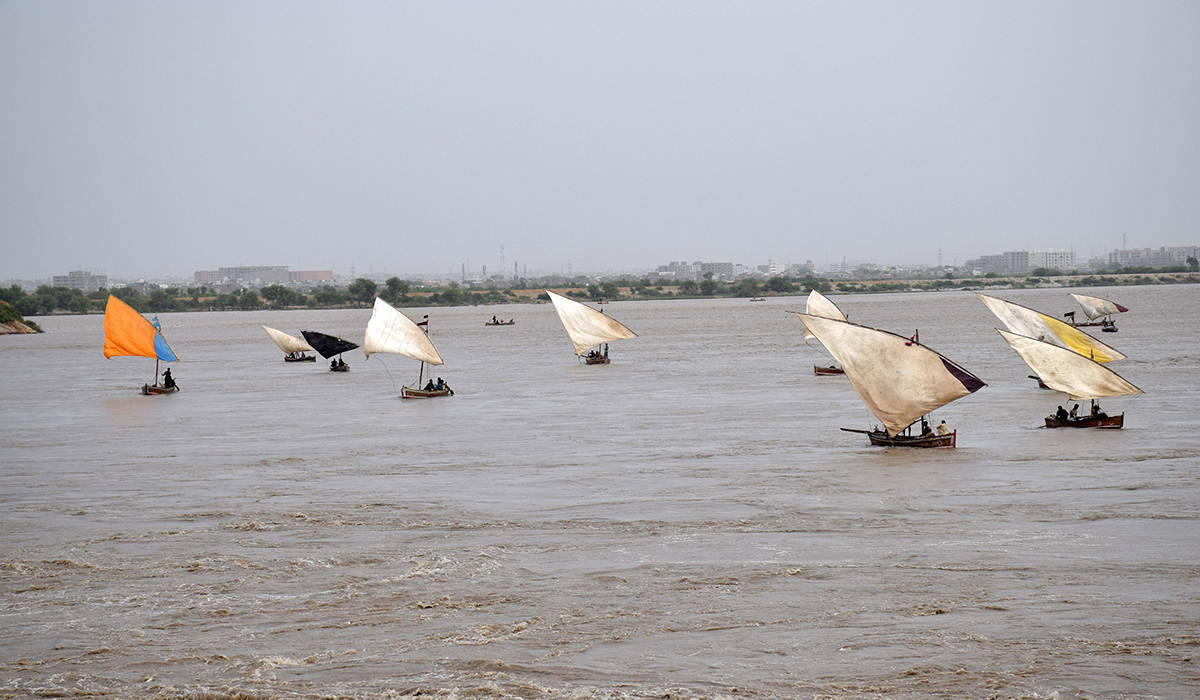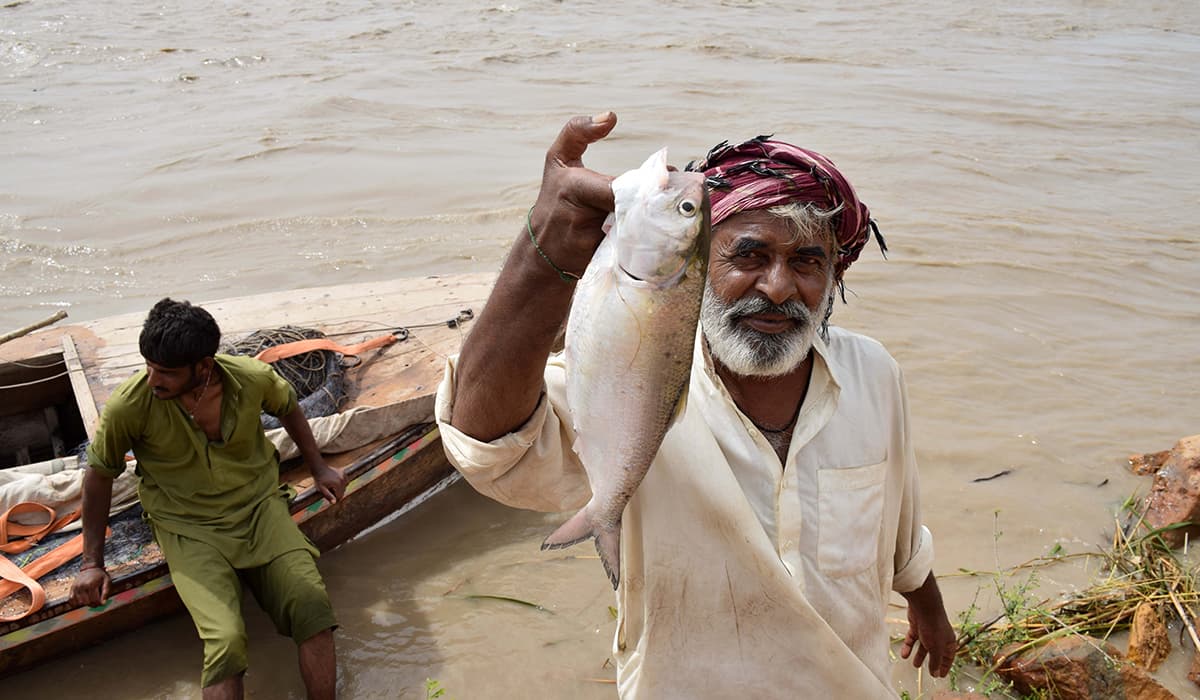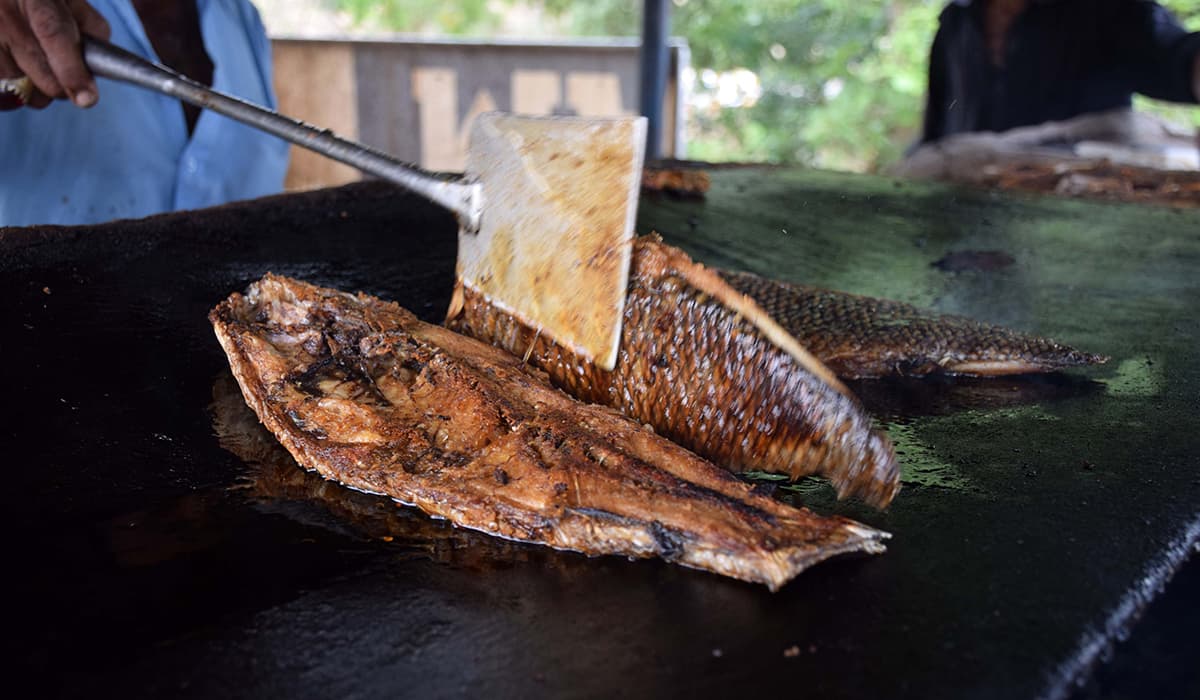Thunder Bolt
FULL MEMBER

- Joined
- Aug 1, 2015
- Messages
- 1,054
- Reaction score
- 1
- Country
- Location

A fisherman shows a freshly caught palla. -Photo by author
It is flooding season again in River Indus, with choppy waters rushing downstream towards the Kotri barrage. Under the water's surface though, there is a different kind of activity. The palla fish zooms ahead, continuing its journey upstream against the powerful river currents.
The palla machli, with its silver body glistening from first light, is trapped. The nets positioned just a stone’s throw away from the imposing gates of the Kotri barrage have worked; and a fisherman, Gul Hassan Mallah, has his first catch of the day.

Preparing nets before setting off. -Photo by author
The palla is unique in more ways than one. Unlike most fish, it swims in a straight line against the strong currents of the river, too fast to be caught with routine and known fishing methods. As such, it requires special methods to catch it — nets known locally as mun, dudi, khas, muno, kacho, and pakko, as well as nylon nets, are produced especially to catch palla.
Secondly, it is not confined to the river Indus, being able to thrive in freshwater as well as saltwater. Arab Mallah, a 70 year old fisherman who is an influential part of a union of fishermen in the region, the Taraqi Pasand Mallah Tanzeem, explained, “There are two kinds of palla. The first one lays its eggs in the river and when the eggs hatch, the fish returns to the sea. The other type of palla lays its eggs in the sea and when the fries grow up after a year or so, they travel towards the Indus.”
But palla's affinity with Sindh is much deeper than just inhabiting its principal river. In fact, the legend of the palla is one often told by mohanas (fishermen). It is believed that when the palla starts traveling upstream from Thatta, it is black in colour. But as it passes by the Zindapir shrine near Sukkur, it gains a shining silver colour all over its skin and boasts a beautiful red spot on its head.

A freshly caught palla. -Photo by author
Gul Hassan Mallah too subscribed to this notion. “It goes to its murshid [shrine] and after paying its respects, returns to the river with a fragrance,” he said, insisting that he has personally witnessed the black body of the palla in Thatta, before it changes colour to its more recognizable appearance.
Gul Hassan also believes that this affects the taste of the palla. A cooked palla in Thatta tastes like a normal fish, he said, but “when you cook palla caught in Jamshoro (further upstream) the entire neighbourhood would smell its aroma."
And what an aroma it is; a scent that send hunger pangs reverberating throughout one’s body. Fry it or steam it, base it in rice or in curry, the palla provides its exceptionally distinctive taste and smell to every of dish.
Gul Hassan personally prefers the fish roasted, wrapped in a piece of muslin and kept in the soil with some coal providing the necessary heat. Another fan favourite is the palla pulao. And of course, the fried palla, pictured below, is one that never fails to delight the palla lovers.

Fresh palla being fried in a restaurant. -Photo by author.
With a rich historical tradition and an unparalleled taste, the palla maintains an important status in Sindhi culture and society. Along with mangoes, the palla is often gifted to people in Sindh’s cities and villages. Families also do not miss the opportunity of having palla for lunch or dinner during the flood season. And no official gathering or meeting is complete without palla on the menu.
Part of the reason of its popularity, according to Arab, is that it doesn’t eat anything other than silt, giving its meat a delicious taste.
“This is the only fish that is eaten from tail to head and every part of it has a different taste”, he said. In fact, in order to meet the demand for palla during off-season, palla has to be especially imported from Iran’s Zahidan area to be sold in Sindh’s markets.
Dwindling fish
In recent decades however, palla numbers have fallen in Sindh, hence it has led to an increase in imports from Iran.
Once upon a time, palla and the River Indus were inseparable. Gul Hassan recalls a time when fishermen would find it hard to hold nets between 150ft to 200ft tightly as it was always full of palla.
These days though, it is a different story. “Things have drastically changed, we caught only five fish in our last trip on the river,” he said with despondency etched on his face.
Another batch of fishermen passing by us in the river also attested to this problem. “We have been fishing since 6 in the morning and it is now 3 pm; we were able to catch only these two”, one of them said.

Returning back from another low-haul trip. -Photo by author
The population of palla, it is largely believed, was abundant until the 1960’s when few dams were present upstream the River Indus.
People like Arab Mallah vouch for the fact that palla used to be caught in the thousands in the Indus just two to three decades back. They also claimed that the fish could once be found all the way upstream in Multan, at a time when three barrages in Sindh – Guddu, Sukkur and Kotri - were not built on the river.
One reason for the declining production of palla is attributed to the use of banned nets – bollo and gujjo - at the mouth of River Indus in Thatta district. They contain strings made of iron which injure the fish, hence affecting its production. Unfortunately, they remain in use as no action has been taken by the relevant authorities.
Another cause for falling numbers of the palla fish is the inconsistent flows of water in the River Indus. Proper production of palla requires sustainable flows, and it seemed as if the government also recognised this.
In 2005, the federal government conducted a study through an international panel of experts to determine the correct amount of water which needs to be released downstream from Kotri, according to the report at least 5,000 cusecs of water should be released per day throughout the year.
Despite this study being initiated on the federal government’s request, consistent water flows in the Indus remain a distant pipedream.
Arab told us that in reality, the flow of water downstream from the Indus was only seasonal, with floodwater being released only between March to August. Although this did roughly correspond with the palla season, the fluctuating levels of river water, combined with the use of banned nets, has virtually decimated the population of palla.
Consequently, the fishermen and the consumers both pay a heavy price.
Every year, as forecasts of floodwaters are released, fishermen like Gul Hassan prepare to borrow funds from lenders to prepare their boats and nets for palla season, spending anywhere from Rs50,000 to 200,000, but with flows usually discontinued in only ten days, the poor fishermen become debtors in vain and as such multiply their woes.
And for the consumers, the nagging fear now, is that unless something is done to address the dwindling numbers of palla in the River Indus, this magical fish that is considered intrinsic to Sindhi cuisine and culture will have to suffer the ignominy of going extinct in its native land.
The palla adventure - in pictures

Fishermen prepare their boat for a trip down the river. -Photo by author

Nets have been cast, waiting for the catch. -Photo by author.






